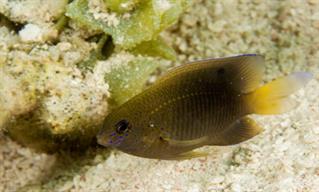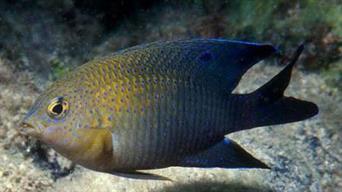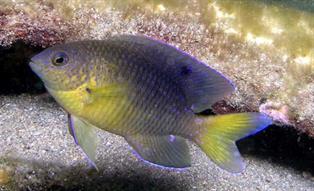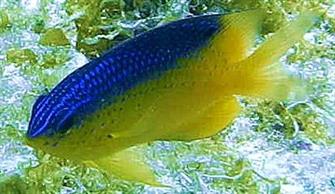




Stegastes leucostictus
| Ecological Descriptors | ||||
| Habitat | Size (cm) | Diet | Behaviour | Sex |
| Dem (Co, R, S) | 10 | Veg, Car, Wor, Mol | Ter | F |
Beaugregory Adult
Beaugregory Juvenile
Description:
Adult: Two common forms (plus varients in between):
1. Entire head, body and fins may be grey-brown, with yellowish spots on scales of the upper back, small blue spots evenly distributed over most of the head, spotted blue lines along the base, center and edge of dorsal fin. Sometimes a small black (& blue) spot on middle of last few spines of dorsal fin.
2. Snout, nape, upper back under spiny dorsal and spiny dorsal blackish grey; remainder of head, body and dorsal fin, and all other fins bright yellow; blue marks as in pattern 1.
.Juveniles: Upper head and back blue, remainder bright yellow. Blue lines on snout and through eye extend onto upper back. Prominent a black ocellus ringed in blue on base of last few spines of dorsal fin, which does not extend onto the upper body (cf Cocoa Damselfish, C. variabilis). No black spot on caudal peduncle. Small blue spots on yellow parts of head and upper body.
Ecology
Found around coral or rocky reefs, as well as sandy areas, seagrass beds and rubble. It is also found around mangrove shores and sponge beds, but is less common on flourishing coral reefs. They influence the algal and the benthic community structure, due to their
aggressive and territorial behaviour and spend much of their time chasing other fish species away, to secure their food supply and deter egg predators e.g. Bluehead Wrasse. They remain within 50 cm from the substrate.
Make clicking noises to communicate.
They feed on amphipods, gastropods, foraminiferans, marine worms, green and brown microalgae and cyanobacteria. Their incisiform (chisel-like) teeth enable them to eat algae off of rocks and substrate, and have the most acidic stomachs of any reef fish to aid digestion..
Life Cycle:
The eggs are deposited inside empty shells or under stones shells
Greater priority is placed on defending high quality sites rather than mating. Males not guarding eggs pay more attention to females, or often move and go in search of higher quality territories. Female damsel fish use aggressive behaviour to influence the selection of males by other females.
Dipping, herding darting and making clicking sounds are actions done to encourage a female to enter a male’s nesting site. Males safeguard the nest, fan the eggs to ensure they are well oxygenated and pick out any dead eggs from within the clutch. This is the only form of direct parental care juveniles receive.
Adult: Two common forms (plus varients in between):
1. Entire head, body and fins may be grey-brown, with yellowish spots on scales of the upper back, small blue spots evenly distributed over most of the head, spotted blue lines along the base, center and edge of dorsal fin. Sometimes a small black (& blue) spot on middle of last few spines of dorsal fin.
2. Snout, nape, upper back under spiny dorsal and spiny dorsal blackish grey; remainder of head, body and dorsal fin, and all other fins bright yellow; blue marks as in pattern 1.
.Juveniles: Upper head and back blue, remainder bright yellow. Blue lines on snout and through eye extend onto upper back. Prominent a black ocellus ringed in blue on base of last few spines of dorsal fin, which does not extend onto the upper body (cf Cocoa Damselfish, C. variabilis). No black spot on caudal peduncle. Small blue spots on yellow parts of head and upper body.
Ecology
Found around coral or rocky reefs, as well as sandy areas, seagrass beds and rubble. It is also found around mangrove shores and sponge beds, but is less common on flourishing coral reefs. They influence the algal and the benthic community structure, due to their
aggressive and territorial behaviour and spend much of their time chasing other fish species away, to secure their food supply and deter egg predators e.g. Bluehead Wrasse. They remain within 50 cm from the substrate.
Make clicking noises to communicate.
They feed on amphipods, gastropods, foraminiferans, marine worms, green and brown microalgae and cyanobacteria. Their incisiform (chisel-like) teeth enable them to eat algae off of rocks and substrate, and have the most acidic stomachs of any reef fish to aid digestion..
Life Cycle:
The eggs are deposited inside empty shells or under stones shells
Greater priority is placed on defending high quality sites rather than mating. Males not guarding eggs pay more attention to females, or often move and go in search of higher quality territories. Female damsel fish use aggressive behaviour to influence the selection of males by other females.
Dipping, herding darting and making clicking sounds are actions done to encourage a female to enter a male’s nesting site. Males safeguard the nest, fan the eggs to ensure they are well oxygenated and pick out any dead eggs from within the clutch. This is the only form of direct parental care juveniles receive.
Beaugregory Adult
Beaugregory Adult





(C) Dr P Ryan/ RyanPhotographic

(C) Ross Robertson

(C) Tiswango


339






